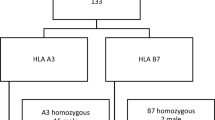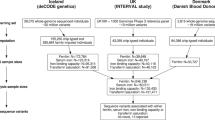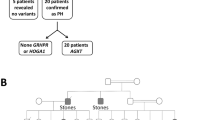Abstract
Haemochromatosis is a common recessive disorder characterized by progressive iron overload, which may lead to severe clinical complications. Most patients are homozygous for the C282Y mutation in HFE on 6p (refs 1–5). A locus for juvenile haemochromatosis6 (HFE2) maps to 1q (ref. 7). Here we report a new locus (HFE3) on 7q22 and show that a homozygous nonsense mutation in the gene encoding transferrin receptor-2 (TFR2) is found in people with haemochromatosis that maps to HFE3.
Similar content being viewed by others
Main
We studied six patients (from two unrelated families of Sicilian origin) who met diagnostic criteria for haemochromatosis8, but were not linked to HFE (Fig. 1a). A clinical description of the two original patients from the large, inbred, family 1 has been reported9. No patients were homozygous for C282Y, but patient II-3 of family 2 was homozygous for H63D, a common polymorphic change implicated in iron overload . We had previously included subjects VII-1 and VII-2 in a genome-wide search performed to map the locus for HFE2 (ref. 7). After having excluded linkage to HFE2, we looked for homozygosity in all affected individuals of both branches of family 1 (Fig. 1a). Pairwise linkage analysis showed a maximum lod score of 4.09 (θ = 0.0) for markers D7S477 and D7S647 on 7q. We further investigated this interval, confirming the linkage and finding regions of homozygosity of less than 1 cM in both families (Fig. 2).
a, Pedigrees of patients harbouring the TFR2 Y250X mutation. All patients had increased transferrin saturation and serum ferritin and most had disease-related clinical complications. Patient V-11 had arthritis and histologically documented cirrhosis; affected siblings had skin pigmentation and abnormal liver function tests. Patient II-3 (family 2) had liver cirrhosis, diabetes and arthritis. Filled symbols, affected; open symbols, unaffected. Haplotypes are defined by markers D7S651, D7S647, D7S2498, D7S2480, D7S734, D7S662, D7S477, D7S1588, D7S740, D7S2536, D7S515 and D7S518, and are coded by letters. Some recombination events were detected in haplotype ‘a’ with external markers, as shown in Fig. 2. ND, not determined. b, Sequencing chromatographs of the forward sequence of exon 6 spanning the TAC→TAG mutation causing the Y250X substitution in two patients (patient 1, V-11; patient 2, VII-1) compared with a normal control. The mutation is indicated by an arrow. c, Segregation of the Y250X mutation as revealed by restriction digestion with MaeI. In normal sequence, two fragments are obtained (281 bp and 169 bp). In the mutated sequence, the 281-bp fragment is cleaved into 177- and 104-bp fragments. The doublet formed by the 177-bp and the constant 169-bp fragment is indicated (arrow). U, undigested fragment; N, normal control.
Top, genetic map of the TFR2 interval. Microsatellites are in italics, STSs are underlined. TFR2 is magnified. R1 and R2 are intragenic polymorphic repeats, respectively, in introns 3 and 9 (primers available on request). YAC clones (from CEPH and chromosome-7–specific library) positive for the markers studied are shown as thin lines. PAC HDJ0037G3 containing TFR2 (ref. 11) is shown as a thick line. Bottom, extent of homozygosity regions found in the two families are shown as bars; the minimal haploidentical area spans less than 1 cM and represents the common ancestral haplotype.
The gene TFR2 was recently isolated and mapped to 7q22 by radiation hybrids10. TFR2 shows 66% homology to the transferrin receptor (encoded by TFRC) in its extracellular domain, binds transferrin and is presumed to mediate cellular iron uptake10. Using available sequence information, we identified two intragenic polymorphic repeats (Fig. 2, R1 and R2) and detected homozygosity for these markers in all affected individuals. Using our own and published11 data, we precisely mapped TFR2 within the homozygosity region (Fig. 2). We scanned the TFR2 coding sequence and exon-intron boundaries for mutations, and detected a C→G transversion in exon 6 at position 750 of the cDNA sequence (Fig. 1b), which replaces a tyrosine (TAC) with a stop signal (TAG) at residue 250 (Y250X). This substitution creates a MaeI site. The amplified TFR2 exon 6 was digested with MaeI to analyse segregation of the mutation in family 1. All affected members of family 1 were homozygous for Y250X, whereas obligate carriers were heterozygous (Fig. 1c). Patient II-3 of family 2 (in which no consanguinity was reported) was homozygous for Y250X. We did not find the Y250X mutation in 100 normal chromosomes or in 12 patients who did not have mutations in HFE.
The role of TFR2 in iron metabolism is poorly understood. TFR2 lacks iron-responsive elements and does not show the iron-dependent post-transcriptional regulation present in other key genes of iron metabolism. Two transcripts have been identified10. The α-transcript product is a transmembrane protein that is primarily expressed in liver in human and mouse10,12. The TFR2 β-transcript is the result of alternative splicing; its protein product may be an intracellular protein and, though widely distributed, is expressed at low levels. The Y250X mutation is located in a region shared by both transcripts. A phenotype of iron overload associated with the absence of a functional gene suggests that TFR2 is more likely involved in iron regulation (as is HFE) rather than in iron uptake. It is also unlikely that TFR2 is involved in iron export, because our patients attained iron depletion by phlebotomies, implying that excess iron can be mobilized from the liver. Although TFR2 is highly expressed in the erythroid K562 cell line (ref. 10, and data not shown), none of our patients showed erythrocyte abnormalities. Rather, they tolerated long-term phlebotomies without developing anaemia. Thus TFR2, in contrast with TFRC (ref. 13), is not essential during erythroid maturation.
The identification of a new gene defective in haemochromatosis adds further evidence to the heterogeneity of this disease and may facilitate the molecular diagnosis of non-HFE related disorders9,14. TFR2 is the second haemochromatosis gene and the 7q22 interval is the third locus (HFE3) so far identified. Considering the geographical and historical relationships between North Africa and Sicily, it is of interest to investigate whether TFR2 is involved in African haemochromatosis, whose molecular basis still remains undefined15. Our results provide new insights into the molecular mechanisms that cause haemochromatosis and offer a tool to investigate the function of a protein with a presumed role pivotal in iron metabolism.
References
Feder, J.N. et al. Nature Genet. 13, 399–408 (1996).
Jazwinska, E.C. et al. Nature Genet. 14, 249–252 (1996).
Carella, M. et al. Am. J. Hum. Genet. 60, 828–832 (1997).
Beutler, E. et al. Blood Cells Mol. Dis. 22, 187–194 (1996).
The UK Haemochromatosis Consortium. Gut 41, 841–844 (1997).
Camaschella, C. et al. Eur. J. Hum. Genet. 5, 371–375 (1997).
Roetto, A. et al. Am. J. Hum. Genet. 64, 1388–1393 (1999).
Piperno, A. et al. Gastroenterology. 114, 996–1002 (1998).
Camaschella, C. et al. Hepatology. 29, 1563–1564 (1999).
Kawabata, H. et al. J. Biol. Chem. 274, 20826–20832 (1999).
Glockner, G. et al. Genome Res. 8, 1060–1073 (1998).
Fleming, R.E. et al. Proc. Natl Acad. Sci. USA. 29, 2214–2219 (2000).
Levy, J.E., Jin, O., Fujiwara, Y., Kuo, F. & Andrews, N.C. Nature Genet. 21, 396–399 (1999).
Pietrangelo, A. et al. N. Engl. J. Med. 341, 725–732 (1999).
Gordeuk, V. et al. N. Engl. J. Med.. 326, 95–100 (1992).
Acknowledgements
We thank E. Gottardi and D. Cilloni for technical support. YAC clones were obtained from the Yac Screening Center (Dibit). This work was supported by Telethon (grant E. 679), E.C. (Contract QLK6-1999-02237), Italian Ministry of Health, Italian Ministry of University and Technologic Research, and CNR-PF Biotecnologie.
Author information
Authors and Affiliations
Corresponding author
Rights and permissions
About this article
Cite this article
Camaschella, C., Roetto, A., Calì, A. et al. The gene TFR2 is mutated in a new type of haemochromatosis mapping to 7q22. Nat Genet 25, 14–15 (2000). https://doi.org/10.1038/75534
Issue Date:
DOI: https://doi.org/10.1038/75534
This article is cited by
-
Fighting age-related orthopedic diseases: focusing on ferroptosis
Bone Research (2023)
-
The mutual crosstalk between iron and erythropoiesis
International Journal of Hematology (2022)
-
Transferrin receptor 2 controls bone mass and pathological bone formation via BMP and Wnt signalling
Nature Metabolism (2019)
-
Haemochromatosis
Nature Reviews Disease Primers (2018)
-
The mechanisms of systemic iron homeostasis and etiology, diagnosis, and treatment of hereditary hemochromatosis
International Journal of Hematology (2018)





